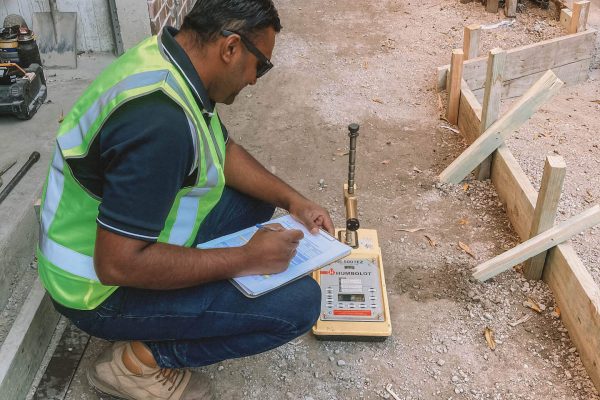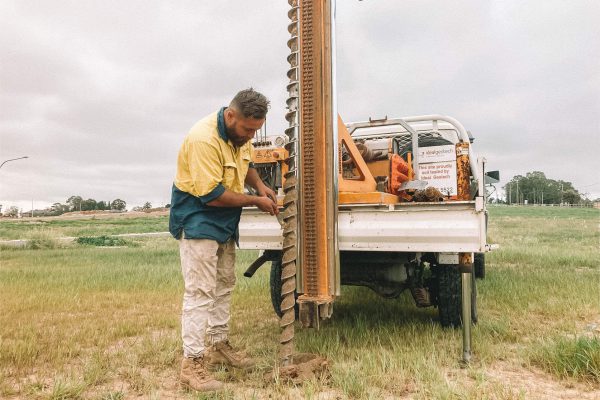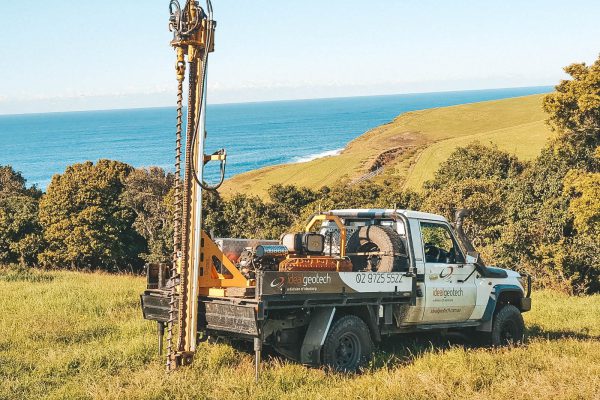
|
PAVEMENT TESTING & DESIGN
Pavement design must be adequate to withstand the loads imposed for the purpose of the pavement use and or by council load requirements. We can provide pavement testing and design for residential & industrial subdivisions, roads, carparks and other pavement types.
We carry out detailed geotechnical field investigations and laboratory testing to provide a comprehensive report for cost effective pavement design of new pavements.
|

|
COMPACTION TESTING
Level 1 and Level 2 testing & inspection In accordance with AS3798-2007 Guidelines on earthworks for commercial and residential developments.Our team will assist you in all aspects of your Level 1 or Level 2 project. As an independent geotechnical testing authority we will reduce technical risks through sharing our experience and knowledge of local quarry products and materials.
This will ensure your project conforms to the design and technical specifications.Level 1 testing and inspection involves a full time representative from Ideal Geotech be present at all times during fill placement, subgrade preparation and any other earthwork operations such as:
- Document removal of topsoil
- Placing of imported or cut material
- Compaction and adding/removal of moisture
- Trenching and backfilling
- Test rolling
- Density testing
On completion of earthworks Ideal Geotech will provide a detailed report outlining inspections, sampling and location of testing carried out.
|

|
WASTE CLASSIFICATION & VENM/ENM TESTING
Validation Report
A validation report (if applicable) shall be submitted to Council or Certifying Authority. The validation report must include the following:
- The degree of contamination originally present;
- The type of remediation that has been completed; and
- A statement which clearly confirms that the land is suitable for the proposed use.
Disposal of Soil & Waste Classification
Before soil can be removed from the site soil has to be classified. Waste is classified under six classifications by the NSW Environment Protection Authority (EPA). The classification of waste into specific groups that pose similar risks to the environment and human health allows for appropriate management and disposal at licensed landfills.
- Special Waste – clinical and related waste, asbestos waste, waste tyres
- Liquid Waste – has an angle of repose of less than 5 degrees above horizontal, become free flowing at or 60 degrees Celsius or when transported, is generally not capable of being picked up by a spade or shovel
- Hazardous Waste – containers previously containing a substance of 1,3,4,5 or 8 as explained by the Transport of Dangerous Goods Code, coal tar waste, lead-acid or nickel-cadmium batteries, lead paint
- Restricted Solid Waste – The highest classification of solid waste though the EPA has not issued a list of pre-classified items to identify them
- General Solid Waste (putrescible) – household waste containing putrescible organics, waste from garbage bins collected by the Council, manure, disposable nappies, food waste, animal waste etc.
- General Solid Waste (non-putrescible) – glass, plastic, rubber, bricks, concrete, paper, cardboard, garden waste, synthetic fibre waste, virgin excavated natural material (VENM) etc.
VENM/ENM Testing
Testing for VENM and ENM is required for any soil that you plan to remove off the site.
If the soil on the site is not classified as ENM or VENM, then it can not be reused in NSW.
Virgin Excavated Natural Material (VENM) EPA Fact Sheet
Virgin excavated natural material means natural material (such as clay, gravel, sand, soil or rock fines):
- That has been excavated or quarried from areas that are not contaminated with manufactured chemicals, or with process residues, as a result of industrial, commercial, mining or agricultural activities
- That does not contain sulfidic ores or soils, or any other waste,
Excavated Natural Material (ENM) EPA Fact Sheet
Excavated Natural Material (ENM) is naturally occurring rock and soil (including materials such as sandstone, shale, clay and soil) that has:
- Been excavated from the ground
- Contains at least 98 per cent (by weight) natural material
- Does not meet the definition of Virgin Excavated Natural Material (VENM)
ENM does not include material that has been processed or contains acid sulphate soils or potential acid sulphate soils.
|






